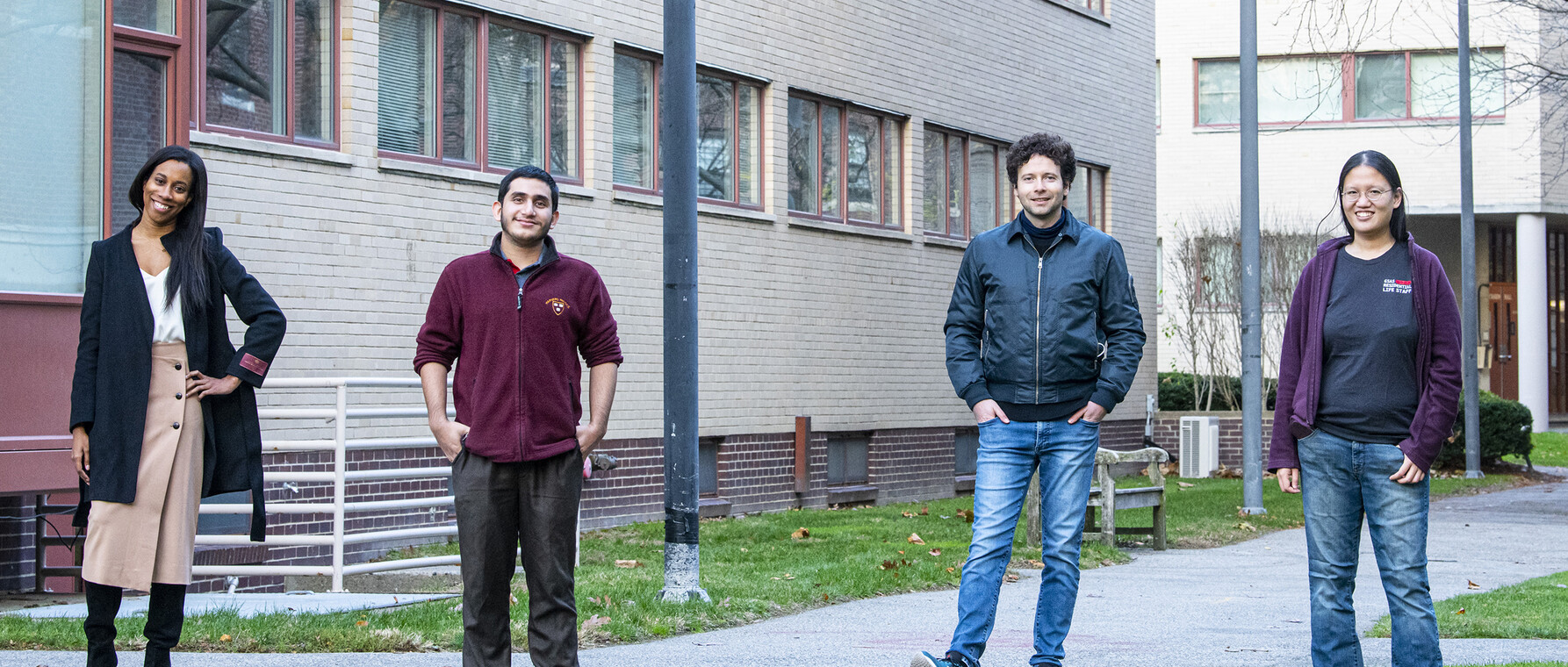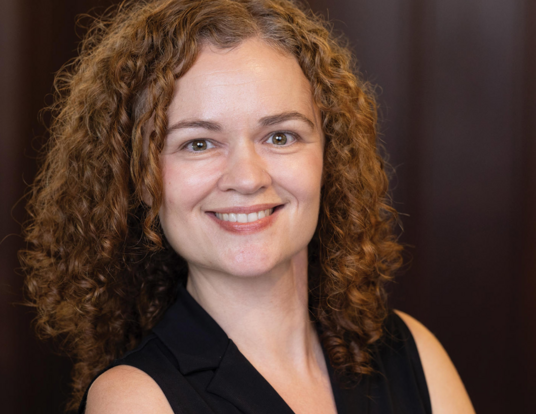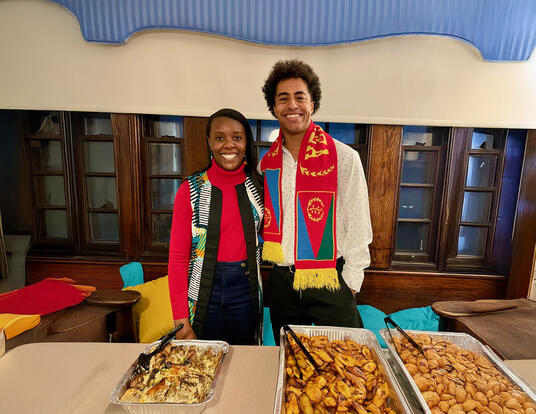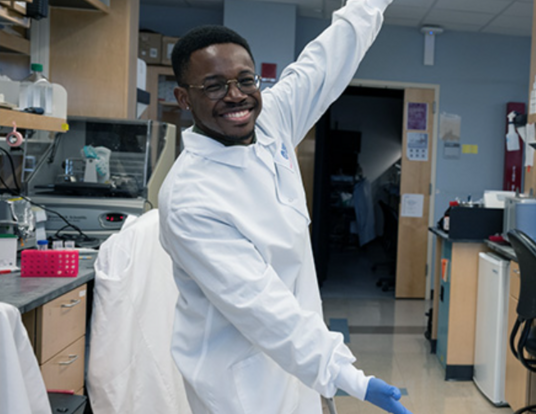Making the Halls a Home
Resident advisors work to create community in a time of COVID

Destiny Crowley misses the way that residential life was at Harvard before COVID-19: the informal chats in lounges and corridors; the get-togethers over lunch or dinner; even just seeing the unmasked faces of the people she lived with. The things she misses most, though, are—quite literally—the little gestures of sweetness that make a residence hall feel like home.
“I used to make my residents chocolate-covered strawberries or bake some cookies and leave them in the lounge,” she says. “That way, they could pick them up throughout the day as they headed out to class or went back to their rooms to study. I really miss providing that little pick me up.”
As a resident advisor (RA) at the Graduate School of Arts and Sciences (GSAS), Crowley is dealing with challenges to campus life not seen in perhaps a century. But while the PhD student in the history of art and architecture and her three fellow RAs serve a much smaller population than in a normal year—and one whose members need to keep their distance—they are no less committed to promoting the sense of community that makes living and working at the School’s four residence halls such a rich experience.
“We hadn’t even heard of COVID”

Ask the four GSAS RAs if any of them thought they’d be staffing mostly empty residence halls when they applied for their positions last winter and all shake their heads.
“I don't think any of us really expected this, especially when we were applying way back in early January,” says Jennifer Shum, a PhD student in mechanical engineering. “We hadn't even heard of COVID.”
The team received their job offers from GSAS’s Office of Residential Life in March, only days before Harvard sent most students home. By that time, Crowley says she had a sense that things might not be back to normal by the time the new school year started.
“Once the University de-densified campus, I thought that things would be very different in the fall,” she says. “It seemed likely that we wouldn't be able to come back to full capacity with all residents. I had the feeling that this was really serious and that things wouldn’t be normal for a while.”
Crowley was right. Five months after Harvard took extraordinary measures to control the spread of the virus on campus, COVID-19 was still spreading in Massachusetts—and across the nation. In response, the GSAS dramatically limited occupancy in its four residence halls: only 49 GSAS students live on campus this year, down from the usual population of over 400. The RA team was smaller too; only 4 versus the full contingent of 15.
Those who did arrive in the residence halls in August were introduced to a routine that was a lot different than the one they were used to testing three times a week; mandatory face masks in all public spaces; no more than six residents to a floor; strict limits on the number of people who could be in any space at the same time.
The strictures were a real challenge for RAs with a passion for promoting a sense of togetherness in the halls.
“In a normal year, there’s a whole spectrum of people in the halls,” says Rhine Samajdar, a PhD student in physics. “There are people who are extroverts and participate in a lot of activities, but I took great pleasure in developing relationships with those on the side, and making them part of the community. That’s something that’s hard to do if you’re not seeing people as much. I worry a lot this year about quieter people falling through the cracks.”
New Ways of Reaching Out
To keep anyone from falling through the cracks, the RAs have looked for ways—some new, some old, some a combination of the two—to reach out. Crowley touts the virtues of online exercise sessions. (“You get to see each other, chat, sweat a little bit. I’m in the best physical shape of my life!”) Others mention online game nights and physically distanced walks along the Charles River. All say they’ll long remember when residents came together on a chilly Halloween night.
“Typically, we have a giant party every year,” Shum says. “It’s a tradition. We do it in the basement of Richards Hall. This year, we had an outdoor pumpkin-carving event. I think it was a lot more fun than people expected—a chance to try something new and find something that we’d appreciate, even in non-COVID times.”
This year, we had an outdoor pumpkin-carving event. I think it was a lot more fun than people expected—a chance to try something new and find something that we’d appreciate, even in non-COVID times.
The RAs say that residents themselves are getting creative about making connections, finding safe spaces for conversations both online and outside. They’re also taking advantage of quirky indoor spaces to be with one another.
“Richards Hall was designed by the Bauhaus architect Walter Gropius,” Crowley explains. “The kitchen contains a porthole right behind the sink that opens out into the lounge. Because of COVID, only one resident can be in the kitchen at a time and only one in the lounge. So, frequently, as I'm passing through the hallway, I will see one resident in the lounge peeking through the porthole to another resident in the kitchen to chat. Certain elements of the building that we live in can facilitate communication, even while people have to be separated.”
While the size of the resident population has shrunk, the RAs say that, in some ways, their responsibilities have grown. With less to do on campus—and fewer people to do it with—new students, in particular, look to their resident advisor to show them around and get them acquainted with life at Harvard.
“During a regular time, you might appreciate less the role of the resident advisor because there are so many things going on,” says Giuseppe Ricciardi, a linguistics PhD student. “At the beginning of the year, though, I realized how the G1s in Conant Hall, for example, were relying on me almost to show them Harvard. ‘Where can we go?’ It made me understand how important the role of the RA is, especially now. To have that point of reference.”
An enhanced understanding of the importance of community—and an enhanced appreciation for the people who hold it together—is something that all RAs say they will carry with them long after they leave Harvard. They say that, for all the challenges, their COVID year has made them more grateful for all they have and for the people who support them.
“There’s so much kindness around us,” says Samajdar. “Ashley (Skipwith, director of residential life), Mari (Lentz, residential life coordinator), and Bob (Byrne, GSAS facilities manager), they work insane hours and are incredibly responsive and thoughtful. They do everything that’s humanly possible to make residential life better, whether that’s ensuring access to the gym or to the libraries, or something else. It says a lot about the system here at Harvard. In a normal year, it's easy to miss.”
Photos by Tony Rinaldo
Get the Latest Updates
Join Our Newsletter
Subscribe to Colloquy Podcast
Simplecast




